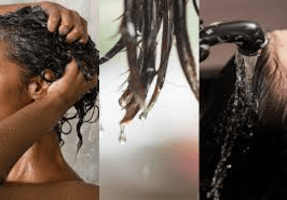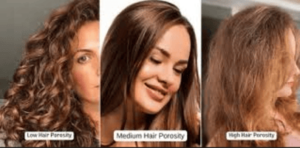Are you struggling with dry, brittle hair that seems to repel moisture no matter what products you use? You may have low porosity hair. This unique hair type requires special attention and care techniques that differ significantly from other hair types.
Low porosity hair has trouble allowing moisture to enter the hair shaft, because of its firmly closed cuticles. This can lead to product buildup, dryness, and difficulty styling. But don’t worry—with the right approach, you can transform your hair care routine and achieve the beautiful, moisturized hair you’ve been dreaming of.
This guide will explore everything you need to know about caring for low porosity hair, from identifying your hair porosity to creating an effective routine that addresses its unique challenges.

Understanding Low Porosity Hair
It’s important to understand what low porosity hair actually is and how it behaves.
Low porosity hair has cuticles that lie flat and tight against the hair shaft. These compacted cuticles create a barrier that makes it difficult for moisture and products to penetrate the hair strand. Think of it like shingles on a roof that are tightly overlapped, preventing water from seeping through.
Characteristics of low porosity hair
- Floats on water instead of sinking
- It takes a long time to get wet in the shower.
- Products sit on top of hair rather than absorbing
- Prone to product buildup
- Resistant to chemical processes like coloring
- It usually takes a while for it to dry.
- May look shiny but feel dry
- Often rejects moisture
Understanding how to care for low porosity hair begins with recognizing these traits in your own hair. Once you confirm your hair has low porosity, you can adapt your haircare approach to address its specific needs.
Testing for Low Porosity Hair
Not sure if you have low porosity hair? You can conduct the following easy tests at home:
The float test
- Take a few clean strands of hair (make sure they’re free of product) and put in a container of water
- Wait 2-4 minutes
- It is likely that your hair has low porosity if it floats on top.
The spray bottle test
- Spray clean, dry hair with water
- If the water beads up and sits on top of your hair rather than absorbing quickly, you likely have low porosity hair
The product absorption test
- On a piece of clean hair, dab a tiny bit of product.
- If the product sits on top of your hair rather than disappearing into the strands, you likely have low porosity hair
Essential Care Tips for Low Porosity Hair
Learning how to care for low porosity hair requires some adjustments to your routine. Here are the most important strategies to incorporate:
Use heat strategically
Heat is your secret weapon when caring for low porosity hair. Warmth helps to lift the hair cuticle, allowing moisture and treatments to penetrate more effectively.
- Apply deep conditioners and treatments to hair that’s been warmed in the shower
- Use a steamer or hooded dryer when deep conditioning
- Try thermal heat caps for deeper conditioning sessions
- Consider warm oil treatments rather than cold ones
Choose lightweight, water-based products
Heavy products can easily overwhelm low porosity hair, leading to buildup and weighing down your strands.
- Seek out goods that list water as the primary ingredient.
- Avoid heavy butters and oils at the top of ingredient lists
- Select leave-in conditioners that are light and liquid-based
- Consider diluting thicker products with water
Clarify regularly
Product buildup is a common issue when caring for low porosity hair, as products often sit on the hair rather than absorbing.
- Use a clarifying shampoo once every 2-3 weeks
- Try apple cider vinegar rinses to remove buildup without stripping
- Consider clay treatments to draw out impurities
- Avoid frequent use of silicones that can create additional buildup
Practice proper layering techniques
The order in which you apply products matters significantly for low porosity hair.
- Always apply products to soaking wet hair first
- Begin with items that are the lightest and most water-based.
- Layer heavier products only as needed
- Depending on what suits your hair the best, apply the LOC (Liquid, Oil, Cream) or LCO (Liquid, Cream, Oil) methods.
Washing and Conditioning Low Porosity Hair
The washing and conditioning phase is crucial when learning how to care for low porosity hair effectively.
Pre-poo treatments
Use a pre-treatment on your hair to protect it before shampooing:
- Use lightweight oils like grapeseed or sweet almond oil
- Before washing, apply to dry hair and let it sit for half an hour.
- Consider steam or heat to enhance penetration
 Shampooing techniques
Shampooing techniques
- To begin, use warm water to loosen the cuticles.
- Focus shampoo on the scalp rather than the length
- Consider sulfate-free shampoos to avoid excessive drying
- Wash thoroughly to prevent buildup
Deep conditioning strategies
- Apply conditioner to soaking wet hair
- Use goods that contain humectants, such as glycerin, honey, or aloe vera.
- Add heat for 15-30 minutes while conditioning
- Rinse with cool water after conditioning to seal the cuticle
Best Ingredients for Low Porosity Hair
When caring for low porosity hair, certain ingredients work better than others:
Beneficial ingredients
- Aloe vera juice: lightweight moisture that penetrates well
- Glycerin: attracts moisture to the hair (avoid in very dry climates)
- Honey: moisture-attracting and moisture-retaining natural humectant
- Hydrolyzed proteins: smaller protein molecules that can penetrate low porosity hair
- Light oils: grapeseed, argan, jojoba, and sweet almond oils
Ingredients to limit or avoid
- Heavy butters: shea butter, cocoa butter (unless used sparingly)
- Heavy oils: castor oil, olive oil (can be used occasionally but not regularly)
- Silicones: can create buildup that’s difficult to remove
- Mineral oil: sits on the hair and prevents moisture penetration
Styling Low Porosity Hair
Styling techniques are just as important as product selection when learning how to care for low porosity hair:
Wet styling tips
- Style hair while still damp rather than completely dry
- Use praying hands method to apply styling products
- Consider diluting gels with water for better distribution
- Apply styling products in sections for even coverage
Heat styling considerations
- Always use heat protectant
- Minimize heat styling to prevent cuticle damage
- Use lower heat settings when possible
- Allow hair to air dry partially before blow drying
Protective styling
- Give your hair breaks with protective styles
- Ensure hair is properly moisturized before installing protective styles
- Avoid styles that are too tight, which can damage the hair cuticle
- Maintain moisture while in protective styles with light sprays

Creating an Effective Routine
Here’s a sample routine to consider:
Weekly routine
- Pre-poo treatment with light oil
- Shampoo with warm water
- Deep condition with heat
- Apply leave-in conditioner to soaking wet hair
- Layer styling products from lightest to heaviest
- Style as desired
Monthly treatments
- Clarifying treatment to remove buildup
- Protein treatment (if needed)
- Hot oil treatment for deeper moisture
Seasonal adjustments
- Adjust humectant usage based on climate
- Use lighter products in humid weather
- Incorporate more moisturizing treatments in dry weather
Common Mistakes to Avoid
When learning how to care for low porosity hair, be aware of these common pitfalls:
Overusing protein
- Low porosity hair typically needs less protein than other hair types.
- Hair that contains too much protein may become brittle and rigid.
- Use protein treatments sparingly, usually no more than once a month.
Skipping heat when deep conditioning
- Without heat, deep conditioners may not penetrate low porosity hair effectively.
- Always use some form of heat when deep conditioning.
Using too many heavy products
- Heavy products will sit on top of low porosity hair, creating buildup and weighing it down.
- Focus on lightweight, water-based products.
Not clarifying regularly
- Product buildup is the enemy of low porosity hair.
- Make clarifying an essential part of your routine.
FAQs
How often should I wash low porosity hair?
Most people with low porosity hair benefit from washing every 7-10 days. However, this can vary based on your lifestyle, exercise habits, and environment. The key is to wash often enough to prevent buildup but not so frequently that you strip your hair of its natural oils.
If you exercise heavily or live in a humid climate, you might need to wash more frequently. Listen to your hair—if it feels weighed down or looks dull, it’s probably time for a wash.
Can low porosity hair use protein treatments?
Yes, low porosity hair can use protein treatments, but they should be used sparingly. While protein can help strengthen hair, low porosity hair often doesn’t need as much protein as other hair types. Consider incorporating a light protein treatment once a month or every 6-8 weeks.
Look for hydrolyzed proteins, which have smaller molecules that can penetrate the hair shaft more easily. Always follow protein treatments with moisture-rich conditioners.
Why does my low porosity hair feel dry even after deep conditioning?
If your low porosity hair still feels dry after deep conditioning, several factors could be at play. You might be using products that are too heavy and simply sitting on top of your hair rather than penetrating it. Heat may not be incorporated properly during your conditioning process—low porosity hair needs heat to open the cuticles and allow moisture in.
Your deep conditioner might contain ingredients that don’t work well with low porosity hair. Try using lighter, water-based conditioners with humectants, and always apply heat during the conditioning process for better results.
Can I color my low porosity hair?
Yes, you can color low porosity hair, but it requires special considerations. The tight cuticles of low porosity hair make it resistant to chemical processes, including hair color. You might need to leave color on longer (within safe guidelines) or use slightly stronger developers to achieve your desired results. However, this can potentially damage your hair if not done properly.
Consider consulting with a professional colorist who understands low porosity hair. Before coloring, proper preparation with clarifying treatments can help the color penetrate more effectively. After coloring, focus on moisture-rich treatments to maintain hair health.
Which oils work best for hair with low porosity?
The best oils for low porosity hair are lightweight oils that can penetrate the tight cuticles. Top choices include grapeseed oil, sweet almond oil, argan oil, and jojoba oil. These oils have smaller molecules that can more easily work their way into low porosity strands.
Avoid heavy oils like castor oil and olive oil for regular use, as they tend to sit on top of low porosity hair. Apply oils to damp hair or use them as hot oil treatments with heat to enhance penetration.
Conclusion…
Understanding how to care for low porosity hair is a journey that requires patience and consistency. By implementing the strategies outlined in this guide—using heat strategically, choosing appropriate products, clarifying regularly, and following proper application techniques—you can transform your hair care routine and achieve the healthy, moisturized locks you desire.
Remember that everyone’s hair is unique, even within the low porosity category. What works perfectly for one person might need adjustments for another. Pay attention to how your hair responds to different products and techniques, and be willing to make modifications as needed.
With time and attention, caring for low porosity hair becomes second nature. The key is working with your hair’s natural characteristics rather than fighting against them. By embracing these specialized care techniques, you’ll discover that low porosity hair can be just as manageable and beautiful as any other hair type.



